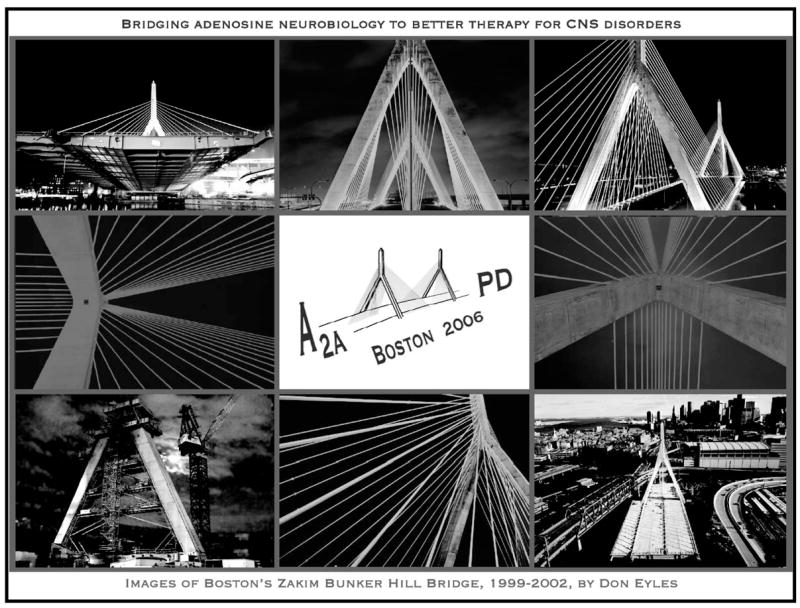In May 2006 – four years after the first international translational research conference on adenosine A2A receptor neurobiology – two hundred academic, government and industry investigators from twenty countries convened in Boston to exchange ideas over continued the progress in this field. At the time of the 2002 conference, construction on Boston’s new architectural icon, the Leonard P. Zakim Bunker Hill Bridge was just being completed (see Figure), providing a local metaphor for the chemical and biological foundations laid over three decades in support of A2A antagonist development for Parkinson’s disease.
Figure.

Program cover for the 2006 research conference, “Targeting Adenosine A2A Receptors in Parkinson’s Disease and other CNS Disorders”, illustrating metaphorically the central translational principle of the meeting and the current issue of Progress in Neurobiology.
During the four intervening years, the Zakim Bridge began carrying motor vehicles to and from the city. At the same time biopharmaceutical programs have carried forward three selective A2A antagonists to phase 2 or 3 randomized clinical trials for improving the often disabling motor symptoms of Parkinson’s disease.
Beyond these clinical advances, recent basic science and epidemiological research has broadened the molecular underpinnings of targeting A2A receptors and its potential for future application to other neurodegenerative and neuropsychiatric disorders including Huntington disease, Alzheimer disease, stroke, HIV encephalopathy, pain syndromes and addiction. In addition recent insights into the molecular and cell biology of adenosine A2A receptors have suggested new opportunities to leverage benefits of A2A blockade in Parkinson’s and other CNS disorders.
In this thematic issue of Progress in Neurobiology investigators at the leading edge of this translational endeavor who spoke at our 2006 conference (www.A2APD.org) have again come together to present an integrated series of updated reviews on the topic. The manuscripts span a range of emerging concepts – from A2A receptor heteromerization to neuroplasticity to neuroprotection, together strengthening the bridge between A2A biology and neurotherapeutic potential. With the first A2A antagonist now under consideration for regulatory approval by the US Food and Drug Administration, we are beginning to cross the bridge and find out where it leads.
Footnotes
Publisher's Disclaimer: This is a PDF file of an unedited manuscript that has been accepted for publication. As a service to our customers we are providing this early version of the manuscript. The manuscript will undergo copyediting, typesetting, and review of the resulting proof before it is published in its final citable form. Please note that during the production process errors may be discovered which could affect the content, and all legal disclaimers that apply to the journal pertain.


